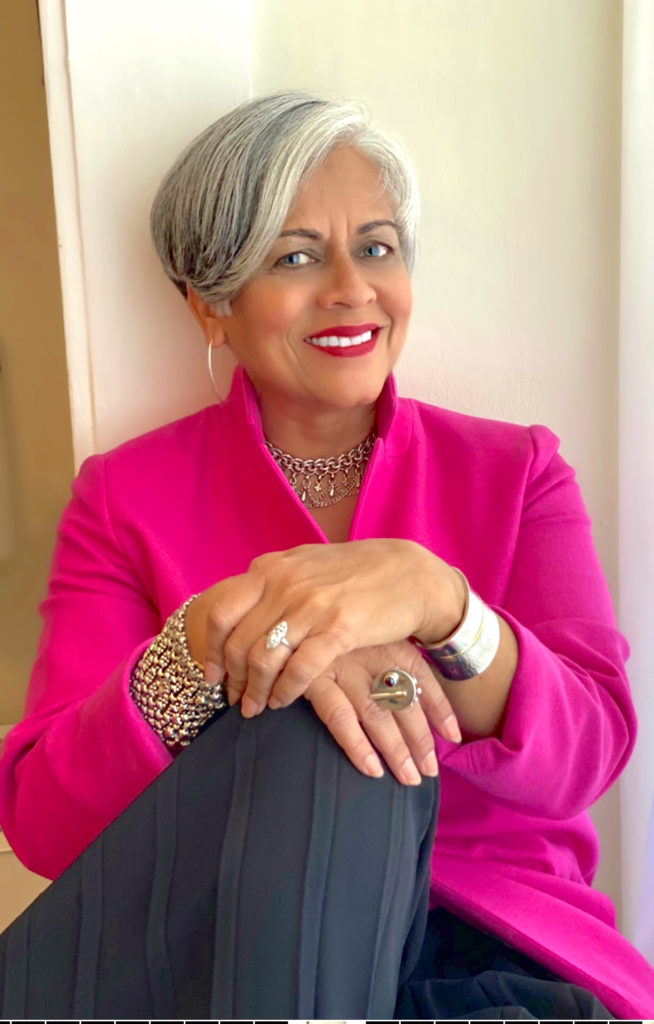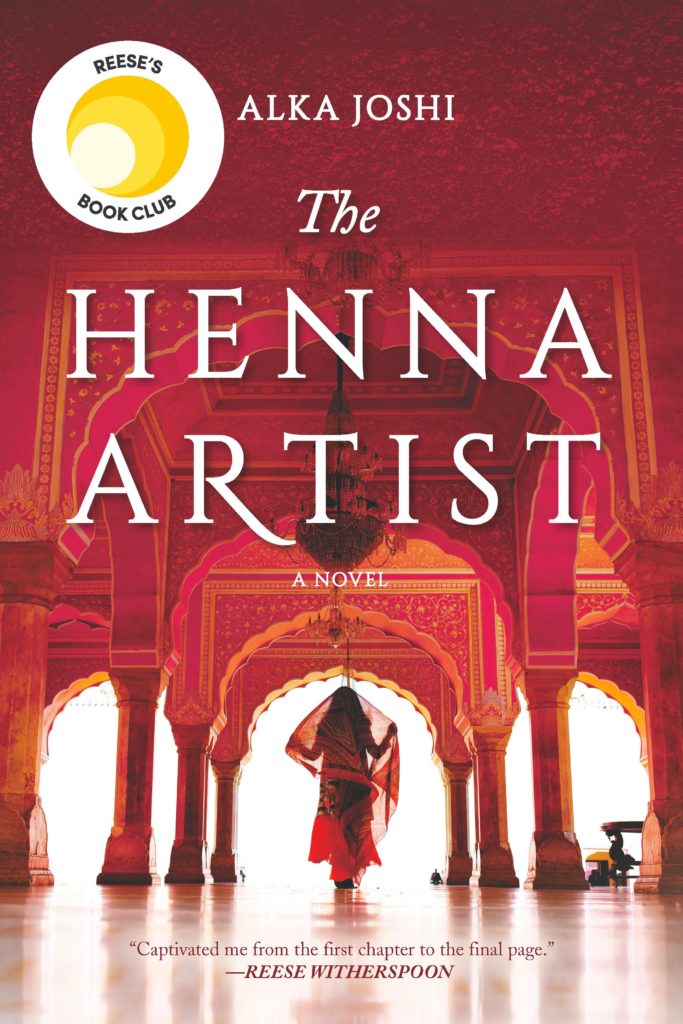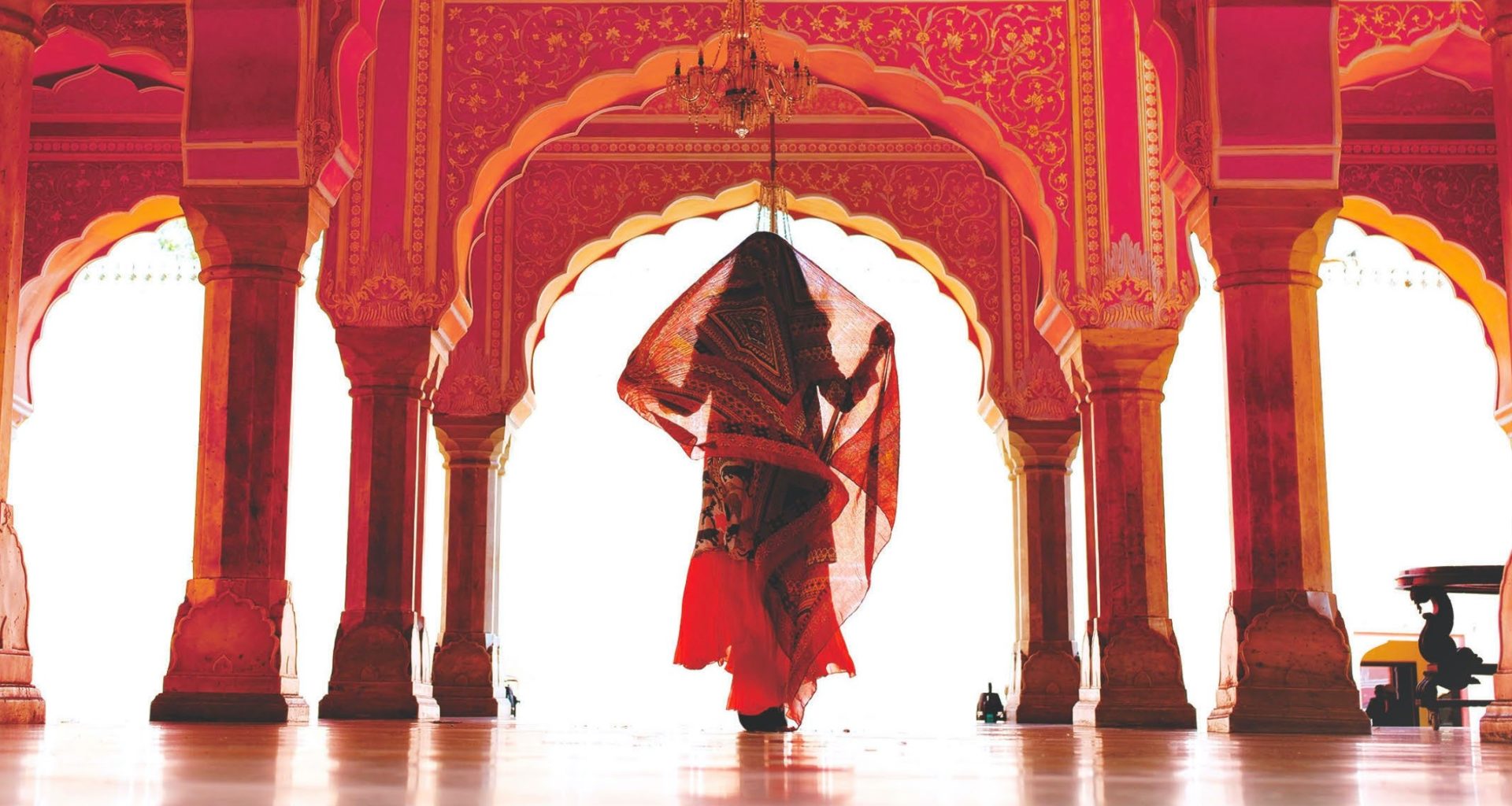
Alka Joshi 
"The Henna Artist," book #1 in The Jaipur Trilogy cover
Alka Joshi’s debut novel The Henna Artist captivated readers across the world and quickly made its way to bestsellers lists, including the Reese Witherspoon Book Club. Since then, the book has developed into a trilogy and is currently being worked into a screen adaptation by Netflix. Born in Jodhpur, Rajasthan, India, Alka has lived in the U.S. since the age of nine. She has a BA from Stanford University and an MFA from California College of the Arts. She ran her own advertising and PR agency for 30 years before writing The Henna Artist.
On the periphery of the 14th edition of the Emirates Airline Festival of Literature in Dubai, we spoke with Alka about her journey and what lies ahead for her and her fictional characters.
Saira Malik (S.M.): The Henna Artist is your first novel that you wrote over 10 years, tell us about the journey of writing it and why it took so long?
Alka Joshi (A.J.): I’d envisioned my life as an artist, not a novelist. I’d been creating advertising and marketing campaigns for 25 years before enrolling in a two-year Master of Fine Arts program in Creative Writing at my husband’s urging. During that time, I was also traveling with my mother several times to Jaipur, where my brother had bought a condo for our family’s use. As my mother introduced me to her India, her girlhood and her early years as a young mother, I began to realize how many aspects of her life had been pre-determined by her family and how she had raised me—very consciously—to lead a very different, independent life where I could forge my own destiny. To thank her, I wanted to give my mother a life in fiction similar to mine. That’s how Lakshmi, the feisty protagonist of THE HENNA ARTIST, was born.
However, when I finished an early draft of my novel (which became my Master’s thesis), my mother died unexpectedly. Bereft, I gave up writing altogether, turning once again to advertising and marketing work. A year later, my thesis advisor called, encouraging me to write another draft, suggesting changes. I sent a revised version to her a year later. She sent it to her agent, who called me immediately from New York. I was elated to be represented by a big NYC agent. We worked on the manuscript for three years while she suggested edits, additions, deletions and improvements to the story. Once she had taken me as far as she could, she recommended I hire an independent editor to take me to the finish line. That process took two editors and another two years, during which time I stopped writing again for a year. After nine years of work on THE HENNA ARTIST, my agent consented to send it out, and MIRA Books, a division of Harper Collins bought it two months later. My acquiring editor requested edits—good ones—that took an additional year. The version readers hold in their hands today is the 30th draft of the original manuscript. It takes a village and a great deal of perseverance and patience to become a novelist.
S.M.: How did this one novel evolve into a trilogy so quickly?
A.J.: Approximately 150 pages were cut from the original manuscript of THE HENNA ARTIST. Much of the deleted narrative was about Malik’s and Radha’s life, both past and future. Because I knew what his life looked like at the age of 20, the character of Malik began insisting I write his story. He is, after all, such a lovable urchin whom I’d come to know well over the ten years it took to complete the final version of the story. THE SECRET KEEPER OF JAIPUR became his story of loyalty, love and a renegotiated familial relationship with Lakshmi. It just poured out of me, taking less than two years. I couldn’t find a way to shoehorn Radha’s story into that book; I decided I needed to write another story about the path she’d taken. In 1974, she’s a lab assistant in a perfume house in Paris—with a Parisian husband and two daughters—when she’s visited by someone she loved dearly as a teenager in Jaipur. That story, the final in the Jaipur Trilogy, will be released March 2023.
S.M.: What is your process of writing a novel?
A.J.: I start with scenes that come to my imagination fully formed. Because of my background as an artist, I’m able to visualize the clothes my characters are wearing, the pattern of the upholstery in the room, whether there’s a candle flickering on a table and I can imagine the scent of that candle. I walk or ride my bike or swim as I keep refining that scene in my head, asking what each character wants from the scene. When I think it’s 90% there, I type it into my laptop. Another scene will pop up immediately afterward, and I follow the same process. I work chronologically, not knowing what the ending will be until I get there. Once I have a full draft, I edit, refine, move scenes around, change the chronology as needed, and keep revising until it feels right. At that point, I turn it over to my editors and my agent to gather their input and start the revision process again…and again.
S.M.: You live in the United States of America, what made you write novels that are set in India?
A.J.: I took my first steps in Rajasthan. My first words were in Hindi. My first solid food was basmati rice. My mother commissioned a tiny salwar kameez for me in the same fabric the tailor used for her clothes. When we came to the U.S., my mother cooked the curries and sweets with spices and ingredients she’d always used. But Iowa—where my father was studying for his Ph.D. in Civil Engineering—wasn’t ready for us in 1967. No one wanted to sit next to me on the bus because I smelled like curry. The American kids asked me why I worshiped cows. My teachers asked why India allowed so much poverty. As a nine-year-old immigrant to the U.S., I heard only negative comments tinged with unflattering judgment about my birth nation. Ashamed and embarrassed, I refused to travel to India for decades. It was only when I began traveling to Jaipur with my mother and researching India’s history pre- and post-independence that I understood the havoc the British had wrought on the formerly prosperous country. Finally, I felt proud to reclaim my heritage. Through my novels, I hope readers understand the many sides of India—the good, the bad and the ugly—as well as her complete history—not just the one written by her colonizers—so that they may appreciate and recognize the resilience of a nation after centuries of domination by the other.

Alka Joshi (Photo: Garry Bailey, 2019) 
"The Secret Keeper of Jaipur," book #2 in The Jaipur Trilogy cover
S.M.: Your characters are so well developed and strong so we can’t help but wonder if they are inspired by people around you?
A.J.: My work is 95% fiction laced with 5% of the details that either I or a member of my family experienced. Except for the character of the younger Maharani, who is loosely based on the Maharani Gayatri Devi of Jaipur, and Lakshmi, who looks just like my green-eyed mother and has her elegant demeanor, everyone else is a product of my imagination.
S.M.: What are some of the challenges you have faced as a writer?
A.J.: Having patience with myself was the biggest challenge. I was frustrated by the process of revision and how many drafts it took to get to a polished manuscript. By how much I didn’t know about sustaining tension throughout a novel. By creating believable characters and having empathy for each one, whether they’re likable or not. I’m used to working hard and finishing projects, and a novel just takes as long as it takes. I had to learn patience.
S.M.: What do you want your readers to take away from your writing?
A.J.: Three things. One, that all women deserve the right to determine their own destiny. Second, just because we know one aspect of a culture, we don’t know the whole of it; like other nations, India is a complex country with many different classes, religions, languages, and history. And lastly, South Asians continue to make large contributions to the world in the areas of science, medicine, and the arts, having settled across the global diaspora.
S.M.: What advice would you give to young and aspiring authors?
A.J.: Pick a topic no one else is writing about. Study with instructors who have published in the last five years because they’ll have the agency and publishing contacts you need. Do your homework to find the juicy nuggets your readers will find as fascinating as you do. Stay with it—even when it seems hopeless. Take time away from writing to breathe, exercise, and hang out with friends.
S.M.: In other exciting news, we know that Netflix is turning your book into a series starring Freida Pinto, how do you want your story to translate onto the big screen?
A.J.: As my executive producers describe it, THE HENNA ARTIST limited series will be an “Indian Downton Abby.” Lush, elegant, and layered with history, character, and atmosphere. You’ll see henna designs being applied on women’s bodies; Lakshmi dancing on her mosaic floor, the map of her life; the rich backdrop of 1950s Indian music and films; and Lakshmi’s day-to-day struggle with societal limitations. Those who’ve never read THE HENNA ARTIST are in for a treat. Those who have read the novel will swoon with delight. I can’t wait!
To learn more about Alka Joshi, visit her official website. The first two installments of the Jaipur Trilogy are out now.
Words by Saira Malik
Images courtesy of Alka Joshi







